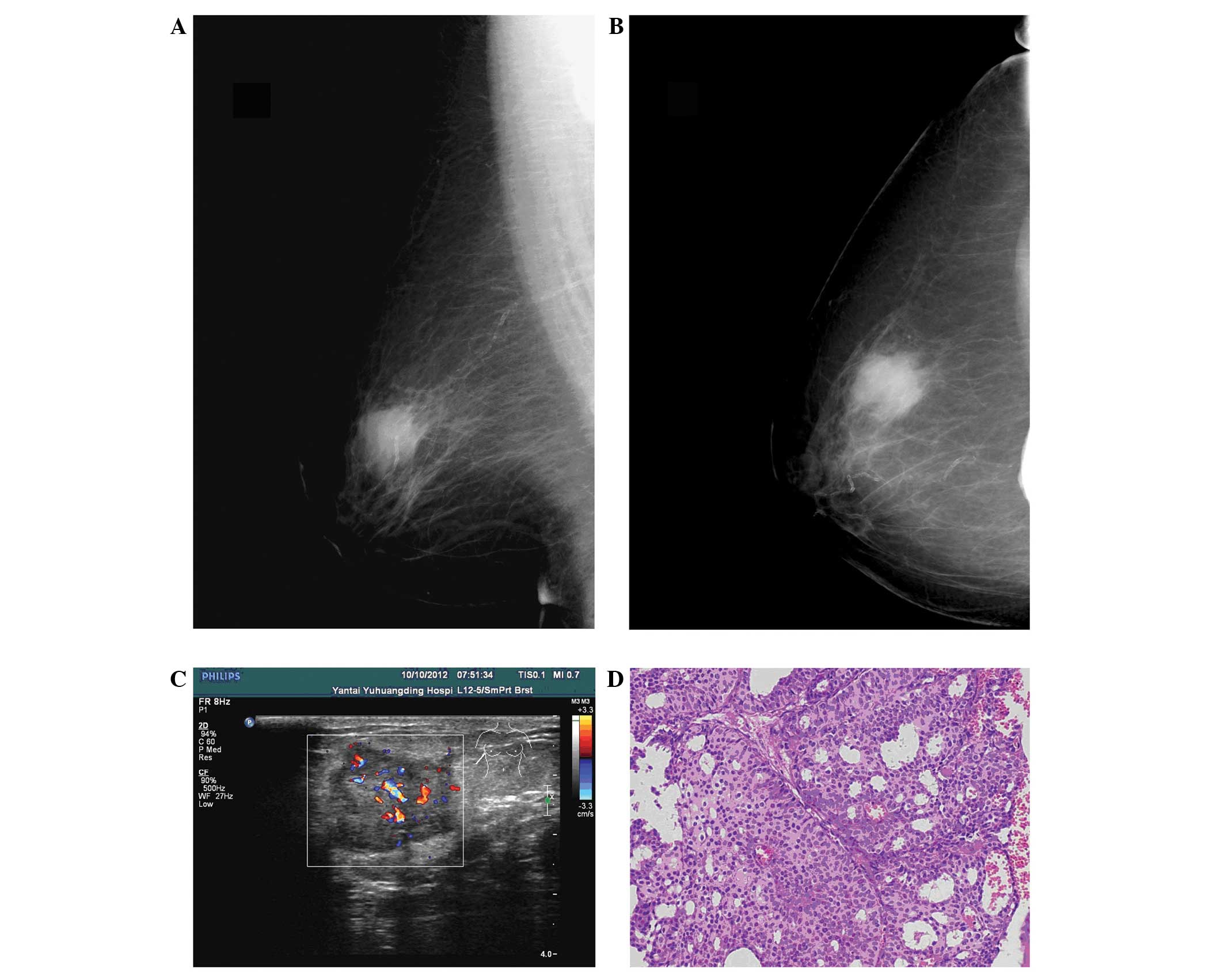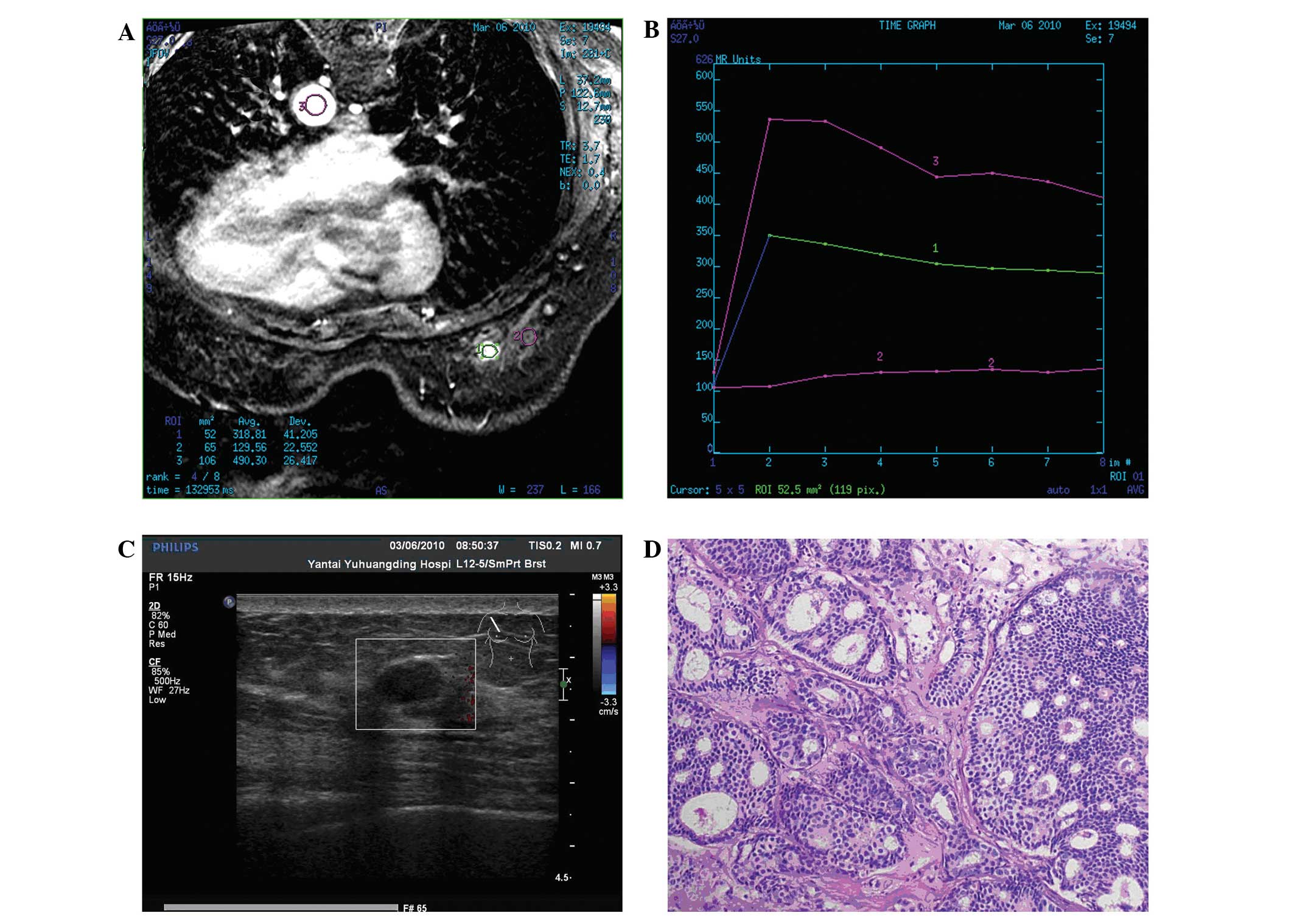Invasive cribriform carcinoma of the breast: A report of nine cases and a review of the literature
- Authors:
- Yizi Cong
- Guangdong Qiao
- Haidong Zou
- Jun Lin
- Xingmiao Wang
- Xiaohui Li
- Yalun Li
- Shiguang Zhu
View Affiliations
Affiliations: Department of Breast Surgery, Yantai Yuhuangding Hospital Affiliated to the Medical College of Qingdao University, Yantai, Shandong 264400, P.R. China
- Published online on: February 17, 2015 https://doi.org/10.3892/ol.2015.2972
-
Pages:
1753-1758
Metrics: Total
Views: 0 (Spandidos Publications: | PMC Statistics: )
Metrics: Total PDF Downloads: 0 (Spandidos Publications: | PMC Statistics: )
This article is mentioned in:
Abstract
Nine cases of infiltrating cribriform carcinoma (ICC) of the breast are reported and the clinicopathological features, particularly the imaging findings, are analyzed in the present study. Sonograms revealed that all masses exhibited a hypoechoic internal echo texture (9/9) and that a number of masses presented with an irregular shape (8/9), obscure boundary (5/9), partially microlobulated (5/9) or well‑circumscribed (4/9) margins, and an inhomogeneous echo (8/9). Mammographic imaging revealed increased radiological density masses (6/8), and sand‑like calcification was not observed in all patients. In two patients, the tumors were mammographically occult. Magnetic resonance imaging performed on one patient revealed a slightly high signal intensity on fat‑saturated T1‑ and T2‑weighted images. Following contrast enhancement, a homogeneous early enhancement was revealed with a quick ascent and quick descent time‑density curve. Immunohistochemistry revealed that all ICCs expressed estrogen receptor and progesterone receptor, but that none were positive for human epidermal growth factor receptor 2. The Ki‑67 labeling index was 3.75% (range, 2‑5%) in the tumor tissue. Four patients were treated with mastectomy and the others with breast‑conserving surgery. Six clinically node‑negative patients underwent sentinel lymph node biopsy; three then received axillary lymph node dissection. Following surgery, three patients received adjuvant chemotherapy, radiotherapy and hormonal therapy, respectively. With a median follow‑up time of 38 months (range, 4‑70 months), one patient developed local recurrence following breast‑conserving surgery; axillary lymph nodes and distant metastases were not observed. This study confirms that this type of carcinoma has unique biological characteristics and a favorable prognosis, but that it remains possible to experience local recurrence.
View References
|
1
|
Page DL, Dixon JM, Anderson TJ, Lee D and
Stewart HJ: Invasive cribriform carcinoma of the breast.
Histopathology. 7:525–536. 1983. View Article : Google Scholar : PubMed/NCBI
|
|
2
|
Venable JG, Schwartz AM and Silverberg SG:
Infiltrating cribriform carcinoma of the breast: a distinctive
clinicopathologic entity. Hum Pathol. 21:333–338. 1990. View Article : Google Scholar : PubMed/NCBI
|
|
3
|
Ellis IO, Galea M, Broughton N, Locker A,
Blamey RW and Elston CW: Pathological prognostic factors in breast
cancer. II Histological type Relationship with survival in a large
study with long-term follow-up. Histopathology. 20:479–489. 1992.
View Article : Google Scholar : PubMed/NCBI
|
|
4
|
Stutz JA, Evans AJ, Pinder S, et al: The
radiological appearances of invasive cribriform carcinoma of the
breast. Nottingham Breast Team Clin Radiol. 49:693–695. 1994.
|
|
5
|
Zhang W, Zhang T, Lin Z, et al: Invasive
cribriform carcinoma in a Chinese population: comparison with
low-grade invasive ductal carcinoma-not otherwise specified. Int J
Clin Exp Pathol. 6:445–457. 2013.PubMed/NCBI
|
|
6
|
Lim HS, Jeong SJ, Lee JS, et al:
Sonographic findings of invasive cribriform carcinoma of the
breast. J Ultrasound Med. 30:701–705. 2011.PubMed/NCBI
|
|
7
|
Zhang W, Lin Z, Zhang T, Liu F and Niu Y:
A pure invasive cribriform carcinoma of the breast with bone
metastasis if untreated for thirteen years: a case report and
literature review. World J Surg Oncol. 10:2512012. View Article : Google Scholar : PubMed/NCBI
|
|
8
|
Colleoni M, Russo L and Dellapasqua S:
Adjuvant therapies for special types of breast cancer. Breast.
20(Suppl 3): 153–157. 2011. View Article : Google Scholar
|
|
9
|
Rakha E, Pinder SE, Shin SJ and Tsuda H:
Tubular carcinoma and cribriform carcinoma. WHO Classification of
Tumours of the Breast. Lakhani SR, Ellis IO, Schnitt SJ, Tan PH and
van de Vijver MJ: 4th edition. IARC Press; Lyon: pp. 43–45.
2012
|
|
10
|
Greene FL, Page DL, Fleming ID, et al:
Breast. American Joint Committee on Cancer Cancer Staging Manual.
6th edition. Springer; New York, NY: pp. 223–240. 2002
|
|
11
|
Wolff AC, Hammond ME, Hicks DG, et al;
American Society of Clinical Oncology; College of American
Pathologists. Recommendations for human epidermal growth factor
receptor 2 testing in breast cancer: American Society of Clinical
Oncology/College of American Pathologists clinical practice
guideline update. J Clin Oncol. 31:3997–4013. 2013. View Article : Google Scholar : PubMed/NCBI
|
|
12
|
Wells CA and Ferguson DJ: Ultrastructural
and immunocytochemical study of a case of invasive cribriform
breast carcinoma. J Clin Pathol. 41:17–20. 1988. View Article : Google Scholar : PubMed/NCBI
|
|
13
|
Nishimura R, Ohsumi S, Teramoto N,
Yamakawa T, Saeki T and Takashima S: Invasive cribriform carcinoma
with extensive microcalcifications in the male breast. Breast
Cancer. 12:145–148. 2005. View Article : Google Scholar : PubMed/NCBI
|
|
14
|
Gatti G, Pruneri G, Gilardi D, Brenelli F,
Bassani G and Luini A: Report on a case of pure cribriform
carcinoma of the breast with internal mammary node metastasis:
description of the case and review of the literature. Tumori.
92:241–243. 2006.PubMed/NCBI
|
|
15
|
Colleoni M, Rotmensz N, Maisonneuve P, et
al: Outcome of special types of luminal breast cancer. Ann Oncol.
23:1428–1436. 2012. View Article : Google Scholar
|











